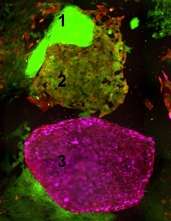When is a stem cell really a stem cell?

(PhysOrg.com) -- Induced pluripotent stem (iPS) cells -- adult cells reprogrammed to look and function like versatile embryonic stem cells -- are of growing interest in medicine. They may provide a way to create different kinds of patient-matched stem cells as treatments for disease, while sidestepping many of the ethical questions surrounding stem cells created from embryos. However, the production of iPS cells is often imprecise, yielding many incompletely reprogrammed cells. Now, researchers at Children's Hospital Boston have developed a technique to help distinguish these cells from the desired pure stem cells.
Rather than relying on single markers to determine a stem cell's status, the new method uses a series of tests to identify the signature of a fully reprogrammed, completely undifferentiated pluripotent stem cell that has the potential to become any type of human cell. The series includes tests for fluorescent markers and tumor formation, as well as karyotyping (examination of the number and composition of a cell's chromosomes) and tests for other molecular characteristics of pluripotency.
"Previous studies often used markers that are insufficient to distinguish fully from partially reprogrammed cells," says Thorsten Schlaeger, PhD, of the Stem Cell Program at Children's, co-senior author of the paper with George Daley, MD, PhD, of the same program. "Such an incomplete test would often designate stem cells as pluripotent even if they were only partially reprogrammed."
Researchers create iPS cell colonies by treating adult cells, such as skin fibroblasts, with either genetic or protein factors that push the cells back to an immature, pluripotent state. Some of the adult cells begin to grow rapidly, forming what look like colonies of embryonic stem cells when viewed under a normal microscope. However, by using antibodies labeled with fluorescent dyes to track visually what proteins these cells are making, Schlaeger, Daley and colleagues showed that these stem cell-like colonies comprise three distinct stages of reprogramming (see image above).
Cells from these three stages underwent further testing. In the tumor formation test, the team injected cells from each stage into mice with weakened immune systems to see if they formed tumors known as teratomas - containing cells that have differentiated into all three primary tissue layers. Formation of these tumors is a sure sign that the cells are indeed pluripotent. However, in the experiments, cells from only two of the three stages of reprogramming formed teratomas, and only one of these formed true, well-differentiated teratomas with the molecular characteristics of fully reprogrammed iPS cells or embryonic stem cells.
The most complete assessment of whether an iPS cell is truly pluripotent must comprise a battery of tests, Schlaeger says. None of the tests are prohibitively expensive or difficult for a stem cell lab, he adds, but many labs may be tempted to cut corners. "Our study creates a standard of analysis in the field," Schlaeger says, "and reminds people to be diligent when characterizing or making claims about putative pluripotent stem cells."
More information: The article, "Live cell imaging distinguishes bona fide human iPS cells from partially reprogrammed cells," was published Oct. 11 in the journal Nature Biotechnology.
Provided by Children's Hospital Boston (news : web)















